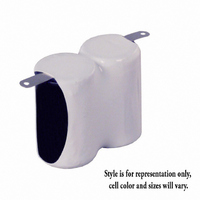P-130SCRC/FTF2 Panasonic - BSG, P-130SCRC/FTF2 Datasheet - Page 8

P-130SCRC/FTF2
Manufacturer Part Number
P-130SCRC/FTF2
Description
BATTERY PK 2.4V 1300 MAH NICAD
Manufacturer
Panasonic - BSG
Datasheet
1.P-130SCRF2.pdf
(87 pages)
Specifications of P-130SCRC/FTF2
Battery Type
Nickel Cadmium (NiCd)
Voltage - Rated
2.4V
Capacity
1300mAh
Battery Cell Size
SC - Flat Top
Number Of Cells
2
Structure
1 Row x 2 Cells Side to Side
Termination Style
Solder Tab
Rechargeability
Yes
Lead Free Status / RoHS Status
Lead free / RoHS compliant by exemption
Other names
P098-F021
RECHARGEABLE NI-CD BATTERIES - CONTINUED
Construction
Rechargeable Ni-Cd batteries are comprised of a
positive electrode plate which uses nickel hydroxide
as its main active material, a negative electrode plate
which uses a cadmium compound as its main active
material, a separator made of a thin non-woven
fabric, an alkaline electrolyte, a metal case, a sealing
plate provided with a self-sealing safety valve, and
other components. The positive and negative elec-
trode plates, isolated from each other by the separa-
tor, are rolled in a spiral shape inside the case and
sealed by the sealing plate by means of an insulation
gasket. In battery types which are designed for high-
current discharge, such as the “P” Series, our unique
collection system is used for the collectors of the
positive and negative electrode plates. By making the
side walls of the metal case thinner, it became
possible for the battery to be lighter in weight and to
have a larger internal volume than previous models.
Battery Reactions
Generally, in rechargeable cells there are three
different electro-chemical reactions: the discharge
reaction which supplies electrical power to the load of
the battery, the charge reaction which restores that
electrical power, and the oxygen gas generation
reaction resulting from the electrolysis of water on
the positive electrode which occurs after the comple-
tion of charge, or, in other words, during overcharge.
For rechargeable Ni-Cd batteries, the charge and
discharge reactions are illustrated by the formula
shown below.
The special characteristic of these reactions is that
the alkaline electrolyte, for example, potassium
hydroxide (KOH), does not apparently contribute
directly to the reactions.
Positive
2NiOOH + Cd + 2H O
nickel
oxyhydroxide Cadmium
metal
Negative
Water
2
Discharge
Charge
2Ni(OH) + Cd(OH)
NICKEL CADMIUM HANDBOOK, PAGE 7
(1st)
Nickel
hydroxide
2
Cadmium
hydroxide
2
The battery is designed so that the capacity of the
negative electrode is larger than that of the positive
electrode, and the gas generated at the positive
electrode is absorbed by reacting with the unreacted
part of the negative electrode, thus making it possible
for the battery to be completely sealed. In this design,
the reactions become as follows.
Insulation Gasket
Positive
Negative
Figure 1 Construction
Negative
Electrode
Collector
Positive
Electrode
Collector
Case
(
)
2OH -
Cap (
Cd
Cd(OH)
+
+
)
1
Safety Valve
/
2
2
O
+
1
2
/
2
O
+
2e -
2
H O
+
2
Sealing Plate
Insulation Ring
H O
FEBRUARY 2002
2
Cd
+
Negative Electrode
Positive Electrode
Cd(OH)
Separator
+
2e -
2OH -
2

























